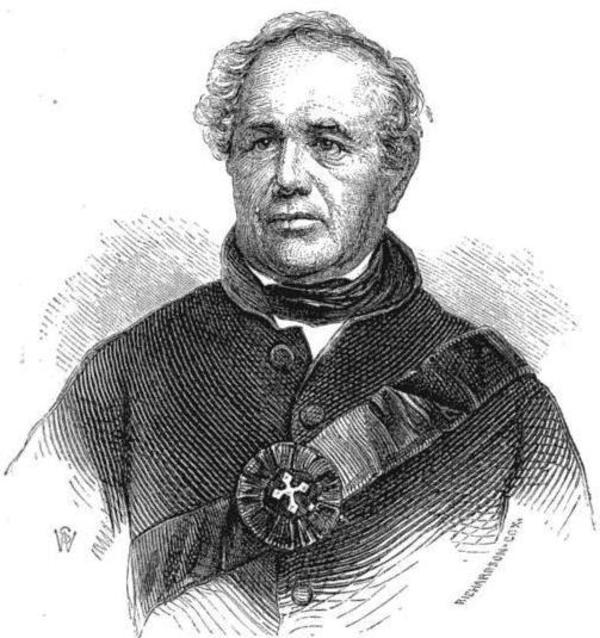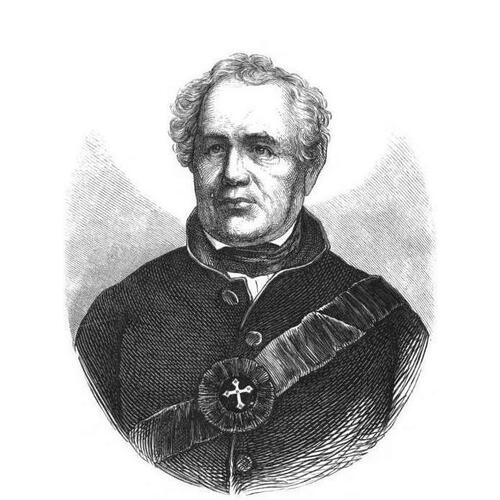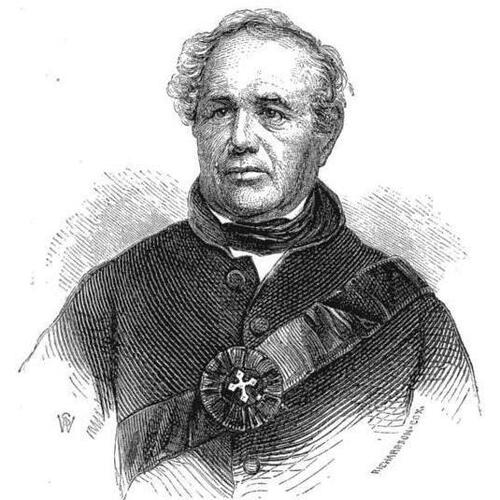
Source: Courtesy of Wikimedia Commons
WILLIAMS, ELEAZER (Éléazar) (Onwarenhiiaki, which means “his head has been split”; baptized Razar Williams), chief of the Caughnawaga (Kahnawake) reserve and Congregational and Episcopalian minister; b. May 1788 on the shores of Lake George, N.Y., son of Tehoragwanegen* (Thomas Williams), chief of the Caughnawaga reserve, and Konwatonteta (Mary Ann Rice); m. 4 March 1823 Madeleine (Magdelene) Jourdain (Jourdon) in Green Bay (Wis.), and they had two daughters who died in infancy and one son; d. 28 Aug. 1858 on the Saint-Régis reserve.
Eleazer Williams was the great-grandson of John Williams*, a Puritan minister who was taken prisoner during Major Jean-Baptiste Hertel* de Rouville’s expedition against Deerfield, Mass., in February 1703/4. His father, Thomas Williams, had him baptized in the Roman Catholic faith the month he was born, and gave him the name Razar, a diminutive of Eleazer. Later, after injuring his head while diving into Lake George, he received the Indian name Onwarenhiiaki. But he was usually called Eleazer Williams. He grew up at Caughnawaga, Lower Canada. In 1800, when he had reached the age for formal education, his father (against the wishes of his mother, who was a devout Catholic) sent him with his brother John to the Congregational seminary at Longmeadow, Mass. At the suggestion of relatives living in Massachusetts, the American Board of Commissioners for Foreign Missions undertook to meet the cost of the young man’s education, providing he adhered to Congregationalism. Shortly afterwards he renounced the Catholic faith and became a Congregationalist.
His studies completed, Williams ministered among the Indians as an itinerant, impecunious preacher, staying principally in Caughnawaga, Oneida Castle, N.Y., Green Bay, and Saint-Régis. He used his spare time to study the history of the Iroquois country; he had already, over the course of time, become an authority on Indian history. An eloquent preacher, he exerted on those whom he called his “racial brothers” an influence that was both political and religious. At the request of the American Board of Commissioners for Foreign Missions, between 1809 and 1812 Williams made several trips to Caughnawaga to introduce Protestantism. In March of the latter year he spoke with such great eloquence that the Indians on the reserve named him their chief. At the beginning of the War of 1812 the American government appointed him superintendent general of the Northern Indian Department; during the conflict he endeavoured to persuade the Caughnawaga Indians to side with the United States [see Atiatoharongwen*], and tried to obtain information on British troop movements.
However, it was in the religious sphere that Williams brought all his resourcefulness into play. In May 1815, not hesitating to change his faith again, Williams joined the Episcopal Church, and then taught catechism at Oneida Castle. Ordained an Episcopalian minister in 1826, he proselytized for his denomination among the Indians of Green Bay, where he had gone to live three years earlier, and continued to work there until October 1834. He went to Saint-Régis in June 1835 and was officially appointed schoolmaster of this mission by the governor of Lower Canada, Lord Aylmer [Whitworth-Aylmer*]. Naturally enough he came into conflict with the Catholic missionaries Joseph Marcoux and François-Xavier Marcoux, who were serving the Caughnawaga and Saint-Régis missions. Finally, as a result of steps taken by Bishop Jean-Jacques Lartigue*, the new governor of Lower Canada, Lord Gosford [Acheson*], intervened in 1836 on behalf of the two Catholic priests, and Williams had no choice but to resign as schoolmaster. Later, from 1846 to 1848 and from 1850 to 1853, he tried again to make converts among his “brothers” and “compatriots,” but without success. On 19 Jan. 1854 Abbé Joseph Marcoux confided to Jacques Viger that as missionary of Caughnawaga he had not “much to fear” from Williams.
In the same year Eleazer Williams suffered another set-back, this time a resounding one, for he found himself stripped of a claim he had cherished for some years – nothing less than a pretension to royal blood: he was the real Louis XVII, who had been abducted from prison in 1795, and who, once in America, had been taken to Caughnawaga and placed by a man named Bellanger in the care of the mixed-blood Thomas Williams. Such was the strange story (“Have we a Bourbon among us?”) given the readers of a newly launched journal, Putnam’s Monthly, in its February 1853 issue. The author was an Episcopalian colleague of Williams, John Halloway Hanson. The French legitimist Henry de Courcy, the New York correspondent for L’Univers of Paris, hastened to demolish this literary extravagance from America in an article published in the 7 March 1853 issue of the Paris paper under the unambiguous title “Un roman d’imagination.” Subsequently, with the help of his Montreal friend Jacques Viger, who provided him with decisive arguments buttressed principally by statements from Eleazer’s mother, Courcy refuted point by point the 480-page volume entitled The lost prince, which Hanson published in 1854. For Courcy, the title of the book was perfectly correct: the prince was indeed lost, and he was not found again.
Collections of Eleazer Williams papers can be found at the Newberry Library (Chicago), Detroit Public Library (Detroit, Mich.), Missouri Hist. Soc. (St Louis), Buffalo Hist. Soc. (Buffalo, N.Y.), and Wisconsin Hist. Soc. (Madison). The Fonda Department of Hist. and Arch. (Fonda, N.Y.) holds a two-volume manuscript biography of Williams. His writings and the works he translated are listed in Bibliography of the Iroquoian languages, comp. J. C. Pilling (Washington, 1888).
Wis., State Hist. Soc., Grignon, Lowe, Porlier papers, vol.55, 4 March 1823. Handbook of American Indians (Hodge), 2: 953–55. E. J. Devine, Historic Caughnawaga (Montreal, 1922), 316–22, 370–71. J. H. Hanson, The lost prince: facts tending to prove the identity of Louis the seventeenth, of France, and the Rev. Eleazar Williams, missionary among the Indians of North America (New York, 1854). Robert [Philippe] Sylvain, La vie et l’œuvre de Henry de Courcy (1820–1861), premier historien de l’Église catholique aux États-Unis (Québec, 1955), 224–61. W. W. Wight, Eleazar Williams, not the dauphin of France (Chicago, 1903). Guillaume de Bertier de Sauvigny, “Louis XVII, un métis indien,” Historia (Paris), 112 (1956): 307–10. L. C. Draper, “Additional notes on Eleazer Williams,” Wis., State Hist. Soc., Coll., 8 (1879): 353–69. A. G. Ellis, “Fifty-four years’ recollections of men and events in Wisconsin,” Wis., State Hist. Soc., Coll., 7 (1876): 207–68; “Recollections of Rev. Eleazer William,” Wis., State Hist. Soc., Coll., 8: 322–52. J. H. Hanson, “Have we a Bourbon among us?” Putnam’s Monthly Magazine (New York), 1 (January–June 1853): 194–217. Moïse Mainville, “Louis XVII est-il venu au Canada?” BRH, 3 (1897): 66–71. Robert [Philippe] Sylvain, “Louis XVII vint-il en Amérique?” Rev. de l’univ. Laval, 3 (1948–49): 743–61, 857–82.
Cite This Article
Philippe Sylvain, “WILLIAMS, ELEAZER (Éléazar) (Onwarenhiiaki), baptized Razar Williams,” in Dictionary of Canadian Biography, vol. 8, University of Toronto/Université Laval, 2003–, accessed December 31, 2025, https://www.biographi.ca/en/bio/williams_eleazer_8E.html.
The citation above shows the format for footnotes and endnotes according to the Chicago manual of style (16th edition). Information to be used in other citation formats:
| Permalink: | https://www.biographi.ca/en/bio/williams_eleazer_8E.html |
| Author of Article: | Philippe Sylvain |
| Title of Article: | WILLIAMS, ELEAZER (Éléazar) (Onwarenhiiaki), baptized Razar Williams |
| Publication Name: | Dictionary of Canadian Biography, vol. 8 |
| Publisher: | University of Toronto/Université Laval |
| Year of publication: | 1985 |
| Year of revision: | 1985 |
| Access Date: | December 31, 2025 |




